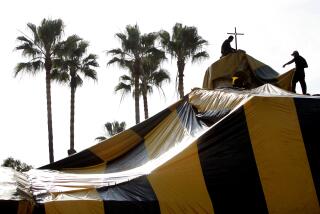PESTS : Termites Are Increasing in U.S.
- Share via
Subterranean termites are the most destructive insects in the United States and they appear to be on the increase (the only major American city free of termites is Fairbanks, Alaska).
Drywood termites and carpenter ants also damage structural woods, but they are not as ferocious as subterranean termites and are not found in all areas of the United States.
Most wood-eating insects like warm, or at least moderate temperatures. Northern states are reporting more infestations each year. Termite-free Fairbanks is roughly 140 miles south of the Arctic Circle.
“In any area where subterranean termites are present in great numbers, they will probably invade your house during its lifetime,” said entomologist Joe Mauldin, who retired last May as the project leader of the USDA Forest Service in Gulfport, Miss.
Subterranean termites live in the soil and are plentiful in states bordering the Gulf of Mexico, as well as in Hawaii and most of coastal California. They are present in somewhat fewer numbers throughout the central Middle Atlantic states and in southern New England. There are moderate to slight infestations in the northernmost states, and a few colonies have been reported in Alaska.
Drywood termites, which make their homes in wood and not in the ground, are rife in Southern California, Arizona, Hawaii and the southern tip of Florida. They are found in mid-size colonies along coastal California, in the Gulf states and along the Atlantic Coast as far north as North Carolina.
Carpenter ants are plentiful in Washington, Oregon and the Northeast quadrant of the United States, as far west as Michigan and as far south as the border between Virginia and North Carolina. Colonies have been spotted occasionally in all other states.
To discover whether termites are present, ask an exterminator to make an inspection. Be sure the firm is competent. Ask neighbors and friends for referrals, determine how long the company has been in business and check with the local Better Business Bureau.
Among 20 categories of service businesses, pest-control firms ranked eighth in complaints during 1992. According to a national Better Business Bureau spokesman, that “isn’t all that bad, but does indicate that a call to one’s local BBB would be wise.”
Many exterminators make free inspections; some charge between $50 and $150. The cost of ridding a house of subterranean termites, based on house size and local competition among exterminators, usually ranges from $300 to $1,000.
The most effective extermination method is to poison the soil with a termiticide before a house is built. To rid an existing house of the pests, a termiticide is pumped alongside and around the foundation’s perimeter and beneath the foundation slab, laying down a contiguous barrier.
Drywood termites are eliminated by fumigating the entire house. Occupants must vacate the premises for at least 24 hours. A tarp is stretched over the house. Then a gas poisonous only to termites is pumped in to kill the pests. The cost generally runs $1,000 to $1,500.
Urban entomologist Herb Field, technical director of Lloyd Pest Control in San Diego, said when the process is completed it is perfectly safe for occupants to return.
More to Read
Sign up for Essential California
The most important California stories and recommendations in your inbox every morning.
You may occasionally receive promotional content from the Los Angeles Times.








